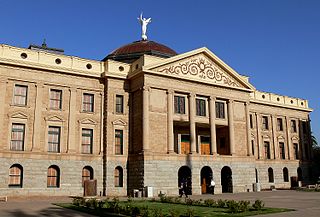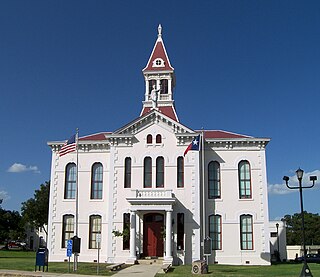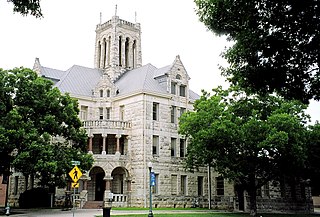
The Allen County Courthouse in Fort Wayne, Indiana is one of 37 United States National Historic Landmarks in the state of Indiana. It was listed on the National Register of Historic Places in 1976 and was designated a National Historic Landmark in 2003.

The Jefferson Market Branch of the New York Public Library, once known as the Jefferson Market Courthouse, is a National Historic Landmark located at 425 Avenue of the Americas, on the southwest corner of West 10th Street, in Greenwich Village, Manhattan, New York City, on a triangular plot formed by Greenwich Avenue and West 10th Street. It was originally built as the Third Judicial District Courthouse from 1874 to 1877, and was designed by architect Frederick Clarke Withers of the firm of Vaux and Withers.

The Bexar County Courthouse is a historic building in downtown San Antonio, Texas, USA.

James Riely Gordon was an architect who practiced in San Antonio until 1902 and then in New York City, where he established a national reputation. J. Riely Gordon is best known for his landmark county courthouses, in particular those in Texas. Working during the state's "Golden Age" (1883–1898) of courthouse construction, Gordon saw 18 of his designs erected from 1885 to 1901; today 12 remain.

The Caldwell County Courthouse is a historic courthouse located in Lockhart, Texas, United States. The courthouse was built in 1894 to replace the existing courthouse, which was too small for the growing county. The courthouse was designated a Recorded Texas Historic Landmark in 1976 and was listed on the National Register of Historic Places as a contributing property of the Caldwell County Courthouse Historic District on January 3, 1978.
The architecture of the U.S. state of Texas comes from a wide variety of sources. Many of the state's buildings reflect Texas' Spanish and Mexican roots; in addition, there is considerable influence from mostly the American South as well as the Southwest. Rapid economic growth since the mid twentieth century has led to a wide variety of contemporary architectural buildings.

The Caldwell County Courthouse Historic District is a historic district located in Lockhart, Texas, the seat of Caldwell County. The historic district encompasses 67 buildings on 250 acres (1.0 km2) across downtown Lockhart. One building included in the historic district, the Emmanuel Episcopal Church, was previously listed on the National Register of Historic Places in 1974. The historic district was added to the National Register of Historic Places on January 3, 1978.

The Santiago E. Campos United States Courthouse is a historic courthouse building located at Santa Fe in Santa Fe County, New Mexico. Formerly designated simply as the United States Courthouse, it was renamed for the late District Judge Santiago E. Campos in 2004.

The Anderson County Courthouse is an historic courthouse located at 1 Public Square in Palestine, Anderson County, Texas. The Beaux-Arts style building was built atop the highest hill in Palestine. Austin architects Charles Henry Page and Louis Charles Page designed the structure. It was built in 1913 and 1914 and dedicated on December 20, 1914 at a cost of approximately $250,000.

The Bandera County Courthouse and Jail are two separate historic county governmental buildings located near each other in Bandera, Bandera County, Texas, The Bandera County Courthouse, built in 1890 at the corner of Main and Pecan streets, is a Renaissance Revival style building designed by San Antonio architect B.F. Trester. It is three-story building with a central clock tower made from rusticated limestone cut from a local quarry. The current jail is a non-historic, modern facility located along State Highway 16 on the north end of town.

The Gonzales County Courthouse is located in Gonzales, capital of the county of the same name in the U.S. state of Texas. It was designated a Recorded Texas Historic Landmark in 1966 and was added to the National Register of Historic Places in 1972.

The Llano County Courthouse and Jail were erected separately, but added to the National Register of Historic Places in Texas on December 2, 1977 as one entry. The courthouse, located in the middle of Llano's historic square, was built in 1893. The exterior is made of sandstone, marble, and granite. The interior of the courthouse was damaged by fire in 1932 and again in 1951. It is still in use today by local government. The jail was erected in 1895, with the prisoner cells on the second and third floors, and the ground level solely for the office and living accommodations for the sheriff and his family. The jail was designated a Recorded Texas Historic Landmark 1979, Marker 9448. The courthouse was designated a Recorded Texas Historic Landmark 1980, Marker number 9446.

The Hood County Courthouse Historic District in Granbury, Hood County, Texas encompasses 12 acres of land. The principal building in and the focal point of the district is the historic Hood County Courthouse built in 1890-1891. Other major buildings include the 1885 Hood County Jailhouse, the 1885 First National Bank Building, the 1891 building which formerly housed the Hood County News, the 1893 Aston-Landers Saloon Building, the 1893 Nutt Brothers Building and the 1886 Granbury Opea House. On June 5, 1974, the district was added to the National Register of Historic Places. The nomination form called it "one of the most complete nineteenth century courthouse squares in Texas." The district is also recognized as a State Antiquities Landmark and includes several Recorded Texas Historic Landmarks.

The Wilson County Courthouse and Jail are located in Floresville, Texas. They were added to the National Register of Historic Places in Texas in 1978 and the courthouse as a Recorded Texas Historic Landmark in 1984.

The Fredericksburg Memorial Library, also known as the Pioneer Memorial Library or the Old Courthouse, is located at 115 W. Main Street, Fredericksburg, Gillespie County, in the U.S. state of Texas. Designed by Alfred Giles, it was built in 1882 to replace the original 1855 courthouse, and was later superseded by the current 1939 courthouse designed by Edward Stein. The first floor houses the Pioneer Memorial Library, while the second floor functions as community hall. It is often called the McDermott Building because of the 1967 and 1984 restorations funded by Mr. & Mrs. Eugene McDermott. It was added to the National Register of Historic Places in 1971, and was designated a Recorded Texas Historic Landmark in 1967.

Alfred Giles (1853–1920) was a British architect who emigrated to the United States in 1873 at the age of 20. Many of the private homes and public buildings designed by Giles are on the National Register of Historic Places and have been designated Recorded Texas Historic Landmarks. Based in San Antonio, his buildings can be found predominantly in south Texas and northern Mexico. Giles is credited with "a profound influence on architecture in San Antonio."

The Comal County Courthouse is located in New Braunfels in the U.S. state of Texas. It was added to the National Register of Historic Places in Comal County, Texas in 1976 and designated a Recorded Texas Historic Landmark in 1993.

The McCulloch County Courthouse is located in Brady, McCulloch County, in the U.S. state of Texas. It was added to the National Register of Historic Places listings in McCulloch County, Texas in 1977, and became a Recorded Texas Historic Landmark in 1967.

The Old Berrien County Courthouse Complex is a historic district containing four significant structures, three former county buildings and a house. It is located in Berrien Springs, Michigan and roughly bounded by Cass, Kimmel, Madison and Union Streets. It was listed on the National Register of Historic Places in 1982.
Hopkins County Courthouse may refer to:





















